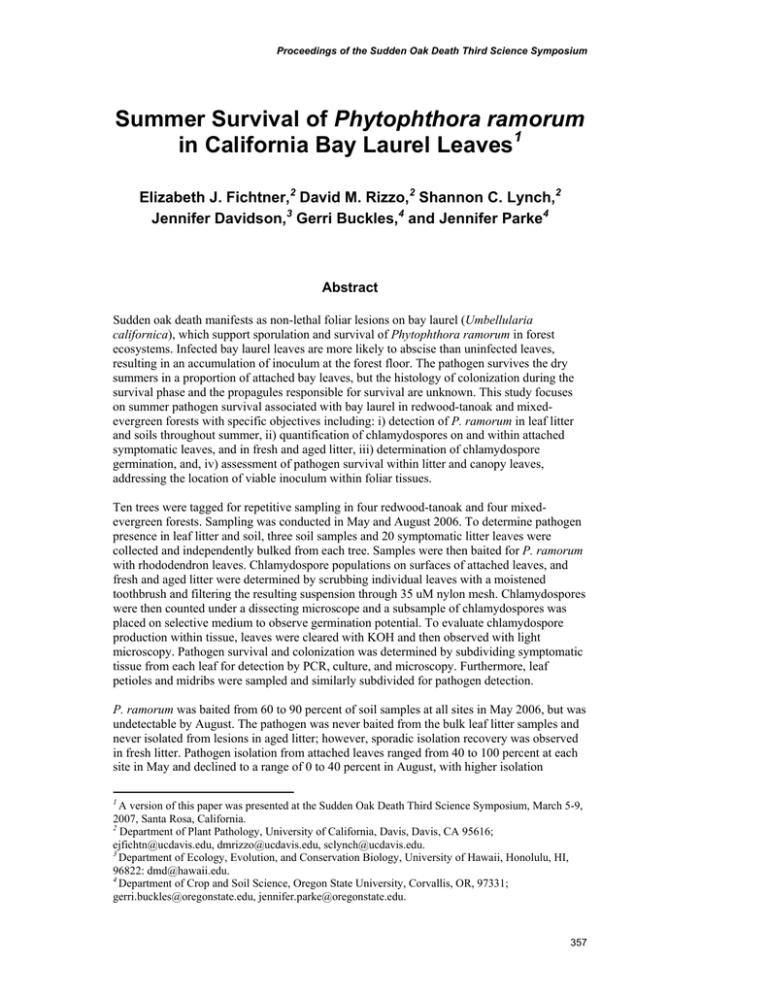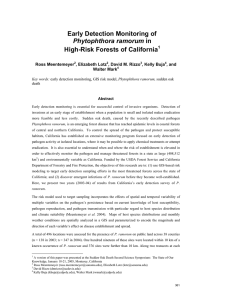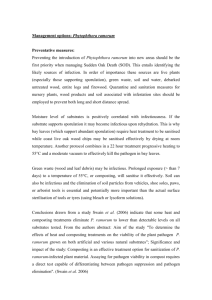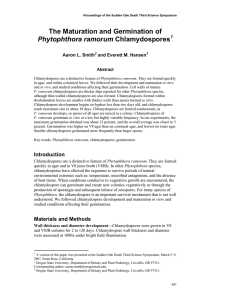Phytophthora in California Bay Laurel Leaves
advertisement

Proceedings of the Sudden Oak Death Third Science Symposium Summer Survival of Phytophthora ramorum in California Bay Laurel Leaves1 Elizabeth J. Fichtner,2 David M. Rizzo,2 Shannon C. Lynch,2 Jennifer Davidson,3 Gerri Buckles,4 and Jennifer Parke4 Abstract Sudden oak death manifests as non-lethal foliar lesions on bay laurel (Umbellularia californica), which support sporulation and survival of Phytophthora ramorum in forest ecosystems. Infected bay laurel leaves are more likely to abscise than uninfected leaves, resulting in an accumulation of inoculum at the forest floor. The pathogen survives the dry summers in a proportion of attached bay leaves, but the histology of colonization during the survival phase and the propagules responsible for survival are unknown. This study focuses on summer pathogen survival associated with bay laurel in redwood-tanoak and mixedevergreen forests with specific objectives including: i) detection of P. ramorum in leaf litter and soils throughout summer, ii) quantification of chlamydospores on and within attached symptomatic leaves, and in fresh and aged litter, iii) determination of chlamydospore germination, and, iv) assessment of pathogen survival within litter and canopy leaves, addressing the location of viable inoculum within foliar tissues. Ten trees were tagged for repetitive sampling in four redwood-tanoak and four mixedevergreen forests. Sampling was conducted in May and August 2006. To determine pathogen presence in leaf litter and soil, three soil samples and 20 symptomatic litter leaves were collected and independently bulked from each tree. Samples were then baited for P. ramorum with rhododendron leaves. Chlamydospore populations on surfaces of attached leaves, and fresh and aged litter were determined by scrubbing individual leaves with a moistened toothbrush and filtering the resulting suspension through 35 uM nylon mesh. Chlamydospores were then counted under a dissecting microscope and a subsample of chlamydospores was placed on selective medium to observe germination potential. To evaluate chlamydospore production within tissue, leaves were cleared with KOH and then observed with light microscopy. Pathogen survival and colonization was determined by subdividing symptomatic tissue from each leaf for detection by PCR, culture, and microscopy. Furthermore, leaf petioles and midribs were sampled and similarly subdivided for pathogen detection. P. ramorum was baited from 60 to 90 percent of soil samples at all sites in May 2006, but was undetectable by August. The pathogen was never baited from the bulk leaf litter samples and never isolated from lesions in aged litter; however, sporadic isolation recovery was observed in fresh litter. Pathogen isolation from attached leaves ranged from 40 to 100 percent at each site in May and declined to a range of 0 to 40 percent in August, with higher isolation 1 A version of this paper was presented at the Sudden Oak Death Third Science Symposium, March 5-9, 2007, Santa Rosa, California. 2 Department of Plant Pathology, University of California, Davis, Davis, CA 95616; ejfichtn@ucdavis.edu, dmrizzo@ucdavis.edu, sclynch@ucdavis.edu. 3 Department of Ecology, Evolution, and Conservation Biology, University of Hawaii, Honolulu, HI, 96822: dmd@hawaii.edu. 4 Department of Crop and Soil Science, Oregon State University, Corvallis, OR, 97331; gerri.buckles@oregonstate.edu, jennifer.parke@oregonstate.edu. 357 GENERAL TECHNICAL REPORT PSW-GTR-214 recovery observed in redwood-tanoak forests than in mixed-evergreen forests. Additionally, chlamydospore populations on attached leaf surfaces were higher in redwood-tanoak than in mixed-evergreen forests in both May and August 2006, but no chlamydospore germination was observed, regardless of the origin of the spore. Populations of chlamydospores were present, but highly variable in leaf litter. Detectable inoculum declined over the duration of the summer with lower foliar survival observed in mixed-evergreen forests than in redwood-tanoak forests. Bay laurel leaves in redwood-tanoak forests supported abundant surface chlamydospore production, but the mechanisms inciting enhanced spore production and the role of these propagules in the survival of P. ramorum and epidemiology of sudden oak death is yet unknown. Key words: Phytophthora ramorum, Umbellularia californica, survival. 358








